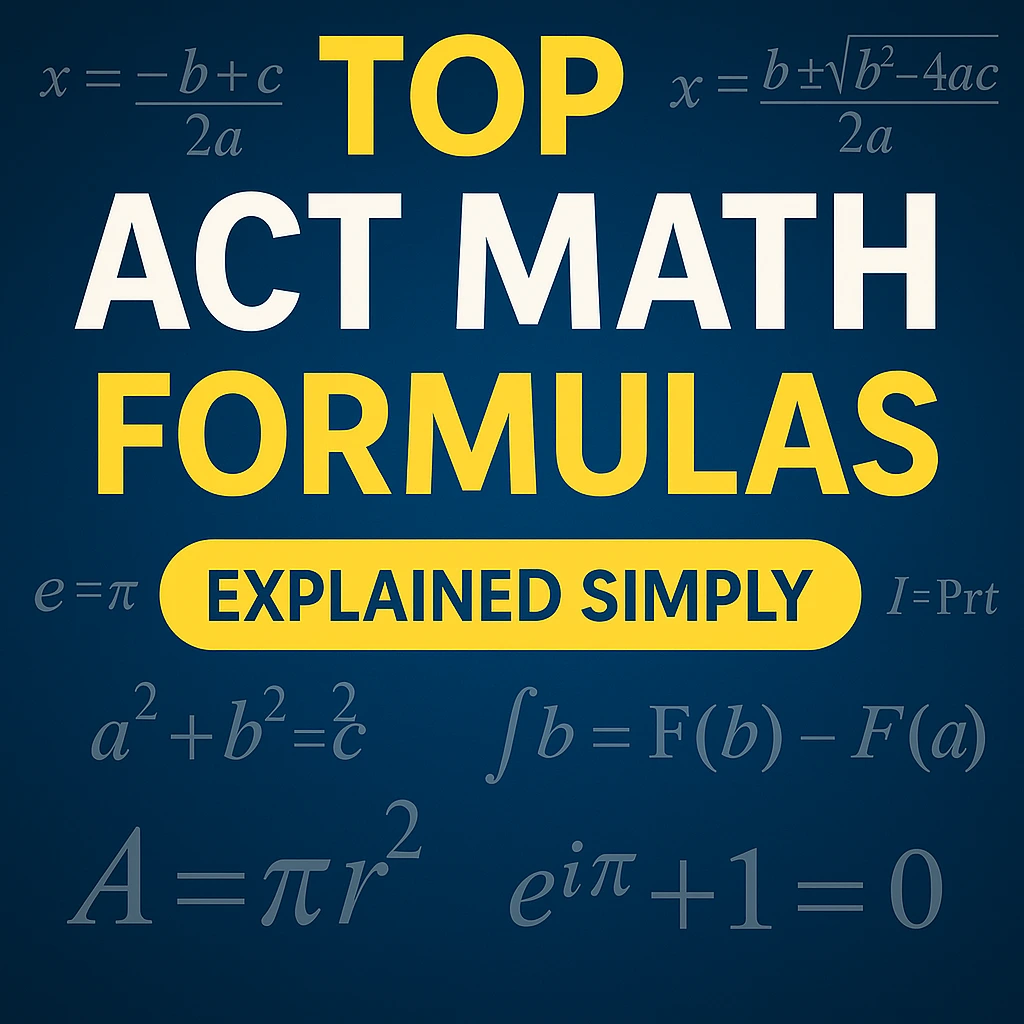Important ACT Math Formulas You Must Know

Math has always fascinated me, and one of the coolest parts about it is how formulas act like shortcuts, which solves complex problems quickly and efficiently. They allow us to describe complex ideas. In this post, we will discover some of the most important ACT Math Formulas. And I feel after reading them and practicing them, anyone will get more comfortable with math.
📲 Ready to Supercharge Your Studies?
✨ Study Friend – Your AI-powered study partner is here!
🚀 Instantly generate flashcards, mindmaps & quick facts from any topic.
🎯 Stay focused. Learn faster. Score higher.👉 Install Study Friend on Google Play and start learning smarter today!
Important ACT Math Formulas You Must Know
1. Pre-Algebra
- Percentage Formula: \(\text{Percentage} = \frac{\text{Part}}{\text{Whole}} \times 100\)
- Average (Mean) Formula: \(\text{Average} = \frac{\text{Sum of all terms}}{\text{Number of terms}}\)
- Proportion Formula: \(\frac{a}{b} = \frac{c}{d} \quad \text{(cross-multiply to solve for unknowns)}\)
2. Elementary Algebra
- Linear Equation:
\(y = mx + b\)
Where:
- $m$ is the slope
- $b$ is the y-intercept
- Quadratic Formula: \(x = \frac{-b \pm \sqrt{b^2 - 4ac}}{2a}\)
- Factoring a Quadratic Equation: \(ax^2 + bx + c = (px + q)(rx + s)\)
- Difference of Squares: \(a^2 - b^2 = (a + b)(a - b)\)
- Sum of Squares: \(a^2 + b^2 \neq (a + b)(a - b)\)
3. Intermediate Algebra
- Slope Formula: \(m = \frac{y_2 - y_1}{x_2 - x_1}\) Where $(x_1, y_1)$ and $(x_2, y_2)$ are two points on the line.
- Systems of Equations (Substitution or Elimination):
- For substitution: Solve one equation for one variable and substitute it into the other.
- For elimination: Add or subtract equations to eliminate one variable.
- Factoring: \(ax^2 + bx + c = a(x - r)(x - s)\)
4. Coordinate Geometry
- Distance Formula: \(d = \sqrt{(x_2 - x_1)^2 + (y_2 - y_1)^2}\)
- Midpoint Formula: \(M = \left( \frac{x_1 + x_2}{2}, \frac{y_1 + y_2}{2} \right)\)
- Equation of a Circle: \((x - h)^2 + (y - k)^2 = r^2\) Where $(h, k)$ is the center and $r$ is the radius.
5. Plane Geometry
- Pythagorean Theorem: \(a^2 + b^2 = c^2\) (For a right triangle, where $c$ is the hypotenuse.)
- Area of a Triangle: \(A = \frac{1}{2} \times \text{base} \times \text{height}\)
- Area of a Rectangle: \(A = \text{length} \times \text{width}\)
- Area of a Circle: \(A = \pi r^2\)
- Circumference of a Circle: \(C = 2\pi r\)
- Surface Area of a Sphere: \(A = 4\pi r^2\)
- Volume of a Sphere: \(V = \frac{4}{3} \pi r^3\)
- Surface Area of a Cylinder: \(A = 2\pi r^2 + 2\pi rh\)
- Volume of a Cylinder: \(V = \pi r^2 h\)
6. Trigonometry
- Basic Trig Ratios: \(\sin \theta = \frac{\text{opposite}}{\text{hypotenuse}}, \quad \cos \theta = \frac{\text{adjacent}}{\text{hypotenuse}}, \quad \tan \theta = \frac{\text{opposite}}{\text{adjacent}}\)
- Pythagorean Identity: \(\sin^2 \theta + \cos^2 \theta = 1\)
- Trigonometric Identities: \(\tan \theta = \frac{\sin \theta}{\cos \theta}, \quad \sec \theta = \frac{1}{\cos \theta}, \quad \csc \theta = \frac{1}{\sin \theta}, \quad \cot \theta = \frac{1}{\tan \theta}\)
- Angle Sum and Difference Identities: \(\sin(A \pm B) = \sin A \cos B \pm \cos A \sin B\) \(\cos(A \pm B) = \cos A \cos B \mp \sin A \sin B\) \(\tan(A \pm B) = \frac{\tan A \pm \tan B}{1 \mp \tan A \tan B}\)
7. Probability and Statistics
- Probability Formula: \(P(A) = \frac{\text{number of favorable outcomes}}{\text{total number of possible outcomes}}\)
- Combination Formula: \(\binom{n}{r} = \frac{n!}{r!(n - r)!}\)
- Permutation Formula: \(P(n, r) = \frac{n!}{(n - r)!}\)
- Mean (Average): \(\mu = \frac{\sum x}{n}\)
- Standard Deviation: \(\sigma = \sqrt{\frac{\sum (x - \mu)^2}{n}}\)
8. Complex Numbers
- Addition/Subtraction of Complex Numbers: \((a + bi) + (c + di) = (a + c) + (b + d)i\)
- Multiplication of Complex Numbers: \((a + bi)(c + di) = (ac - bd) + (ad + bc)i\)
- Modulus of a Complex Number: \(|a + bi| = \sqrt{a^2 + b^2}\)
9. Logarithms
- Logarithmic Identity: \(\log_b(xy) = \log_b x + \log_b y\) \(\log_b \left( \frac{x}{y} \right) = \log_b x - \log_b y\) \(\log_b(x^n) = n \log_b x\)
- Change of Base Formula: \(\log_b x = \frac{\log x}{\log b}\)
10. Exponents and Roots
- Exponent Rules: \(a^m \cdot a^n = a^{m+n}, \quad a^m \div a^n = a^{m-n}, \quad (a^m)^n = a^{mn}\)
- Root Rules: \(\sqrt[n]{a^m} = a^{\frac{m}{n}}, \quad (\sqrt[n]{a})^m = a^{\frac{m}{n}}\)
Why These Formulas Matter
What I love about these formulas is that they not only help solve problems but also teach us how the world works—whether it’s calculating the area of a circle or understanding the behavior of curves in calculus. They simplify complex ideas and make math a lot more approachable.
I encourage you to play around with these formulas, experiment, and see how they work in different scenarios. With a bit of practice, they can become second nature, and the next time you’re solving a problem, you’ll be more confident.
Conclusion
I hope this guide helps you master ACT math and feel more comfortable with math. Remember, practice is key, so keep working on these formulas and try to apply them in real-world scenarios. With time, you’ll find that these formulas become second nature, and you’ll be able to solve problems with ease.
You can also check out our other posts on SI Units:-